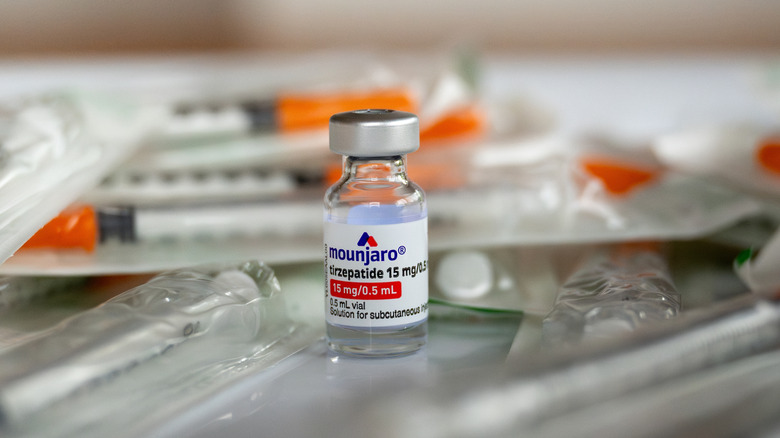The 12 Best Peptides To Improve Your Body
If you've ever considered looking for ways to boost some sort of bodily mechanism, you've most likely stumbled on peptides. Extracted from plants and animals, peptides are strings of amino acids that are isolated based on their functionality and used for an impressively staggering array of issues. But are they really a magical formula that can make you drop 100 pounds and look 20 years younger? As with all things biology related, it's complicated. That's why we've compiled a list of 12 different peptides that have scientific research backing their efficacy so that you know which ones could be effective and which ones might as well be snake oil.
However, you should keep a few caveats in mind. First, none of this should be considered medical advice; always speak with a trained medical professional about your options. Also, realize that, as of this writing, the FDA does not recognize many peptides as being beneficial medications, with some in this very article being put on their 2023 Category 2 list of substances that could have significant safety risks. Always do your research and ensure that, if you decide to use peptides, you buy from a reputable source that shows reports from third-party labs proving the batch you're about to buy contains only what's promised. Okay, with that out of the way, here are the peptides researchers find the most exciting for improving the body's natural processes.
BPC-157
Gastric Pentadecapeptide BPC-157, or Body Compound 157, is a sequence of 15 amino acids that come from our gastric juices and is touted as one of the best peptides for healing currently available. It works by boosting the creation of new blood vessels, known as angiogenesis. The new blood vessels then increase blood flow around damaged tissue in the body, accelerating the healing process. In addition, studies have shown it's an effective peptide for stimulating collagen, modulating inflammation, and boosting the body's response against oxidative stress. It's not currently approved by the FDA for use as a standard medication and is banned by the World Anti-Doping Agency, so people interested in using it should take caution.
BPC-157 has been studied in nearly every realm of body healing for over 40 years, so it's no surprise users consider it a wonder peptide. One of the first studies published in a 1985 edition of the Journal of Applied Physiology showed BPC-157 therapy successfully healed Achilles tendon tears in rats. A 2023 study in Pharmaceuticals found BPC-157 had positive correlations to muscle healing, recovering from heart failure, and reduction of several behavioral conditions, including schizophrenia, depression, and seizures (catalepsy). A study from a 2021 edition of Frontiers in Pharmacology found evidence that BPC-157 could promote faster healing of burns, ulcers, ligament tears, and even helped to maintain transparency of the cornea. Another 2023 study in Pharmaceuticals took eye health even further, observing that BPC-157 therapy had impressive results in reducing or eliminating glaucoma in rats.
Dental researchers have even found BPC-157 to be useful for dental health. A 2009 study in the Journal of Physiology and Pharmacology tested BPC-157 on rats with periodontitis and found it not only helped reduce inflammation but also slowed down the deterioration of the jaw bone.
GHK-Cu
GHK-Cu is a tripeptide consisting glycyl-L-histidyl-L-lysine and copper that's found in human plasma, saliva, and urine. While it's sometimes touted as beneficial for wound healing, users mostly add GHK-Cu to their peptide routines for anti-aging since it's useful for stimulating collagen and blood vessels. It works by acting as a signaling agent in the body to identify and target recovery of damaged or scarred tissues. Unlike many other peptides, it's actually pretty common and easy to get because it's used in anti-aging skincare treatments. Just be sure to look for the signature blue tint that comes from copper to ensure you're getting GHK-Cu and not GHK, which is not as effective.
So how effective is GHK-Cu for anti-aging and skin regeneration? A 2018 study published in the International Journal of Molecular Sciences found evidence it improved tissue repair not only on skin, but connective tissues, stomach lining, bones, and the liver. Researchers also found evidence it could be used to suppress molecules responsible for anxiety, pain, aggression, while activating DNA repair and cell cleansing. A 2012 study in Oxidative Medicine and Cellular Longevity found CHK-Cu's regenerative properties could prevent cognitive decline, corroborated by multiple studies that noted administering GHK-Cu to aging mice improved their cognition, potentially reversing the effects aging has on the brain. But if you're concerned mostly about the anti-aging effects it has on the skin, don't worry. A 2015 Biomedical Research International review noted GHK-Cu helped tighten loose skin while reducing fine lines, wrinkles, photodamage, inflammation, and hyperpigmentation.
GLP-1
Gluocagon-like peptide 1, or GLP-1, is a hormone amino acid chain that comes from the intestine and brain stem. It's created as a reaction to the body's processing of the proglucagon peptide during food intake, working together with processes in the brain that activate while eating. GLP-1 stimulates insulin secretion in the pancreas while replenishing insulin stores to prevent exhausting the body's supplies, making it effective for the management and treatment of diabetes. However, researchers began to notice diabetic patients were also losing weight, thus realizing it had significant potential as an anti-obesity therapy thanks to its ability to slow gastric emptying, which decreases appetite.
GLP-1 is readily available and approved by the FDA for diabetic and obesity treatments. Ozempic, Trulicity, and Saxenda are all brand name GLP-1 medications most people are familiar with, but dulaglutide, exenatide, liraglutide, lixisenatide, and semaglutide are the names you'll find when looking for GLP-1 peptides. While they're effective at weight loss and diabetes management, researchers are finding GLP-1 can do much more. A study published in the Journal of Endocrinology found it was useful for the treatment of Binge Eating Disorder. Meanwhile, a review published in a 2024 edition of The American Journal of Geriatric Psychiatry noted that GLP-1 therapies had the potential to treat depression in test subjects. Finally, a report published in a 2024 edition of Brain Sciences noted GLP-1 users reported positive effects on reducing substance abuse and compulsive behaviors, while increasing sex drive.
GIP
Glucose-dependent Insulinotropic Polypeptide (GIP) is similar to GLP-1, but with a few differences that make it stand out. GIP is a collection of amino acids found in the GI tract that stimulates insulin secretion from the pancreas. Unlike GLP-1, though, GIP was found to stimulate fat accumulation, which might make you think twice about using it as an anti-obesity medication. But to combat this, GIP isn't offered alone; it's typically combined with GLP-1s to boost weight loss. In the peptide world, you'll typically find this as tirzepatide (aka Mounjaro or Zepbound), a GIP and GLP-1 agonist, or retatrutide, a GIP, GLP-1, and glucagon receptor agonist.
GIP agonists have proven to be effective promoting weight loss in several studies. A 2022 study in Cardiovascular Diabetology noted tirzepatide specifically had "unmatched effectiveness" for reducing body weight and improving glycemic control as compared to semaglutide. A 2020 review in Trends in Endocrinology and Metabolism showed that combining GIP and GLP-1 improved white adipose tissue functionality, improving both metabolism and insulin sensitivity. But GIP has some other interesting benefits besides weight loss — a 2021 Nucleic Acids Research study found it could be useful in locating disease biomarkers and cancerous cells, while 2024 studies in both the International Journal of Molecular Sciences and Clinical Medicine Insights found GIP to be a useful antioxidant for reducing bone disorders and improving recovery from spinal cord injuries in rats.
Tesamorelin
Tesamorelin is the synthetic and more potent peptide version of the growth-hormone-releasing hormone, or GHRH. It works by increasing insulin-like growth factor (IGF-1) and endogenous growth hormones, helping to regulate lipodystrophy, a disorder that makes fat deposits accumulate excessively in one area as opposed to a more overall distribution; think of fatty deposits that result in hump backs or beer guts. Originally developed to treat lipodystrophy in HIV patients, researchers are beginning to find it's beneficial for nerve damage repair and potentially slowing down cognitive decline. Tesamorelin is administered via subcutaneous injection.
For HIV patients, a 2014 study in The Journal of Clinical Endocrinology and Metabolism found tesamorelin improved mitochondrial functions and sped up recovery time after exercising, while a 2020 study in the Journal of Clinical Investigation Insight noticed test subjects who were given tesamorelin injections had a significant reduction in non-alcoholic fatty liver disease as compared to the control group. For non-HIV-specific patients, a 2016 study from Expert Opinion on Therapeutic Targets found that tesamorelin accelerated nerve regeneration and limited muscle atrophy after injury, potentially making it a useful solution for people suffering from chronic nerve pain. Meanwhile, a 2013 study published in JAMA Neurology found that tesamorelin injections helped increase cognition of patients in the early stages of dementia, leading some to speculate about its usefulness for combatting cognitive decline caused by aging.
MOTS-c
MOTS-c stands for the mitochondrial open reading frame of the 12S rRNA-c and comes from amino acids found in, you guessed it, the mitochondria. MOTS-c mimics the biological effects of exercise and helps regulate metabolism and insulin sensitivity, making it useful for obesity treatment, optimizing exercise results, and potentially reducing osteoporosis and other age-related diseases. Administered via subcutaneous injection, MOTS-c is a popular peptide for body recomposition but is banned by the World Anti-Doping Agency, so bodybuilders might have issues using this when competing.
Since MOTS-c's discovery in 2015, it's gotten a lot of attention in the research community for its potential uses regulating disease and muscle recovery. A 2023 edition of Frontiers in Endocrinology noted the wide array of successful uses for MOTS-c, including reducing metabolic losses caused by aging, improving heart structure and function, enhancing insulin sensitivity, and reducing inflammation. Studies in the 2022 edition of International Journal of Molecular Sciences and a 2023 edition of the Diabetes & Metabolism Journal corroborated the anti-aging benefits of MOTS-c and also noted its efficacy in managing both Type 1 and 2 diabetes. A 2023 study published in Frontiers in Physiology found MOTS-c both improved bone metabolism while inhibiting the production of osteoclasts, which are cells that break down bone tissue. Finally, to date, multiple studies, including one published in the Journal of Translational Medicine found MOTS-c to have significant benefits for reducing metabolic disorders, muscle atrophy, and biological effects caused by stress.
Melanotan 2
Melanotan 2 (MT-II) is a synthetic version of the α-melanocyte-stimulating peptide hormone. It works by binding with three of the five melanocortin receptors (MCR) in the body, each controlling a different function. Binding with MC-1R results in melanogenesis, or the darkening of the skin and hair. However, further research found it also bound to MC-4R, stimulating the libido in both sexes. It also creates a weak bind to MC-3R, which regulates appetite and energy (though further study is needed). Administered via subcutaneous injection, many users will buy Melanotan 2 for improving sexual functions or for its skin tanning qualities. However, it's worth noting that there is no evidence the tan you'll get is long-lasting, and some users have reported new or increased unevenness in skin pigmentation and a risk of melanoma.
Despite its questionable efficacy as a tanning agent, MT-II has had a revival in the research community as a potential fixer for multiple ailments. A 2017 study published in Oxidative Medicine and Cellular Longevity found that metallothioneins, the protein family Melanotan 2 comes from, had a neuroprotective effect that could be useful in treating Alzheimer's, Parkinson's, strokes, and epilepsy. A 2019 study in PLoS One found Melanotan 2 successfully reversed autistic-like features in adult male mice, while a 2015 study in Neuropsychopharmacology found that using MT-II to stimulate the MC-4R receptor could enhance social function for those suffering from certain psychiatric disorders. In terms of physical effects, a 2003 study in the Annals of the New York Academy of Sciences found MT-II successfully induced penile erections in rats, showing its potential for combatting erectile dysfunctions, while a 2006 study in Pharmacology, Biochemistry & Behavior showed promise for MT-II treating hypoactive sexual desires in female rats.
CJC-1295
CJC-1295 is another synthetic peptide version of the growth hormone-releasing hormone. It increases both the plasma growth hormone and insulin-like growth factor (IGF-1) while also extending the half-life and efficacy of other growth hormones in the body. CJC-1295 is a particular favorite for bodybuilders or those interested in biohacking due to its ability to trigger and boost growth hormone production, but there's also some evidence that it may be effective for both male and female infertility.
A 2024 research paper published in Performance Enhancement & Health reviewed 15,000 online posts for anecdotal evidence of CJC-1295's efficacy and found that both men and women found it useful for injury recovery, mood elevation, and reducing the signs of aging on the skin. For more scientific results, a 2006 article published on the American Journal of Physiology's website noted that CJC-1295 effectively stimulated the pituitary gland in mice, showing its potential usage in treating children with growth hormone disorders.
DSIP
Delta-sleep-inducing peptide, or DSIP, is a peptide found in the hypothalamus and limbic system. DSIP interacts with other peptides and hormones in the pituitary gland, but its ability to trigger sleep isn't fully understood. Still, users will take DSIP via subcutaneous injection or as a nasal spray to help induce sleep and reduce stress. It's also being studied as a potential treatment option for depression, addiction, cancer prevention, and as a blood pressure regulator.
Despite DSIP not being well understood, there is significant research backing its potential treatment for both mental and physical issues. Studies published in European Neurology and other medical journals showed DSIP to be effective at treating chronic insomnia in patients. There have also been multiple studies published, including in the Nordic Journal of Psychiatry, showing a strong correlation between DSIP and major depressive disorder. Another 2005 study in Seizure found DSIP had significant capabilities for decreasing the severity and duration of seizures, leading it to be a potential antiepileptic therapy. Interestingly, there have been multiple studies published, including one in the International Journal of Neuroscience, that found DSIP could reduce pain in human test subjects and rats. Regarding physical efficacy, a 2003 issue of Mechanisms of Ageing and Development noted that DSIP-containing injections increased the lifespan while decreasing spontaneous tumor growths in female mice.
TB-500
TB-500 is a synthetic peptide that's analog to thymosin beta-4 (TB-4), a protein that's made of 43 amino acids and found in most tissues. In the body, it's one of the drivers of actin polymerization, which deals with cell growth and development. Some studies have shown that TB-4 has a multi-modal role in the body, making TB-500 one of the most interesting peptides available because of its potential adaptability. Administered subcutaneously, most peptide users add TB-500 to their repertoire for cellular repair after injury or as a supplement for protecting the body against age-related breakdowns, particularly for reducing hair loss and improving the cardiovascular and immune systems.
Since it's considered such a versatile protein, there are countless studies on the benefits it can produce that run the gamut for health conditions. A 2015 editorial in Expert Opinion on Biological Therapy showed evidence for TB-4 promoting plasticity and remodeling of the brain after suffering a neurological injury or neurodegenerative disease. In addition to neurological repair, multiple studies have shown it has regenerative abilities for the body. A 2014 study in Neuropharmacology showed TB-4 was not only able to help the body repair spinal cord injuries, but the test rats also had markedly less scarring than control subjects. A 2018 review published in Expert Opinion on Biological Therapy found that TB-4 could improve vascular systems, making it helpful for preventing or repairing damage caused by diseases. A 2007 study in the Annals of the New York Academy of Sciences even showed that TB-4 successfully promoted hair growth, making it helpful not only for body repair but also as a novel therapy for people suffering from hair loss.
Ipamorelin
Ipamorelin is a pentapeptide derived from human growth hormones and similar to ghrelin, which binds to the receptors in the body for growth hormone release. It gives a significant boost to plasma growth hormone levels, a hormone responsible for weight gain and tissue repair. However, ipamorelin is unique because its functionality is very selective in the body and seemingly has no effect on functions related to things like cortisol release. So, why would someone want to add something so specific in its functionality to a peptide stack? Well, the research shows that, like Liam Neeson in "Taken," its specific skillset may be precise, but it's very good at what it does, making this a powerful peptide if you're suffering from bone or musculoskeletal pain.
A 2001 comparative study published in Growth Hormone & IGF Research showed ipamorelin successfully counteracted damage caused by glucocorticoid steroids, preventing bone loss and muscle weakness. A 2000 study in the Journal of Endocrinology also found ipamorelin injections not only increased bone mineral content in test rats, but led to notable gains in both bone density and growth as compared to control subjects. Interestingly, it's also seeing potential in use for protecting the function of certain bodily systems, such as the digestive system. A study published in the Neuroendocrinology Letters showed an injection of ipamorelin promoted insulin secretion in the pancreas, making it a potential therapy for diabetes treatment. Another study published in a 2012 edition of the Journal of Experimental Pharmacology showed ipamorelin successfully stimulated gastric emptying in rats, the delaying of which is a common and serious disorder typically seen post-abdominal surgery.
AICAR
5-aminoimidazole-4-carboxamide ribonucleotide, or AICAR as it's more commonly known (and much easier to say), is related to adenosine monophosphate , a nucleotide linked to energy processes in the cell in the body (and which is related to ADP, perhaps a familiar term from biology). Peptide users typically add it to their stack due to its anti-inflammatory and cellular repair properties, particularly around the heart and cardiovascular systems. However, it's also sometimes used to boost the effects of exercise and even has some usefulness in combatting infertility.
Multiple studies have shown AICAR's restorative properties on the body. A 2015 study in Molecular Medicine showed intravenous injections of AICAR successfully rolled back damage to the gut and its tissues caused by intestinal ischemia and reperfusion, a critical injury to the intestines that can have a significant ripple effect throughout the body. A 2022 study in PLoS One also noted that AICAR therapy lowered inflammation and oxidative stress while inhibiting post-operative adhesion in the abdomen, reducing the time and severity of recovery from abdominal surgery. A 2021 study in the European Respiratory Journal took AICAR's healing capabilities even further, finding it beneficial for repairing lung injuries caused by toxic gas inhalation. Regarding exercise performance, a 2024 study in the Journal of Cellular Cardiology found AICAR to be a useful cardioprotective agent, improving cardiovascular functions and reducing the chances of heart failure in test rats. This was corroborated by a 2009 study published in Cell that found AICAR-treated test mice had higher endurance levels, lower body fat, and increased oxygen levels in the lungs. Regarding fertility, a 2018 study in Cellular Physiology and Biochemistry found that AICAR treatments improved sperm mobility and function, paving the way for its use as a potential peptide for patients struggling with reduced sperm fertility.












